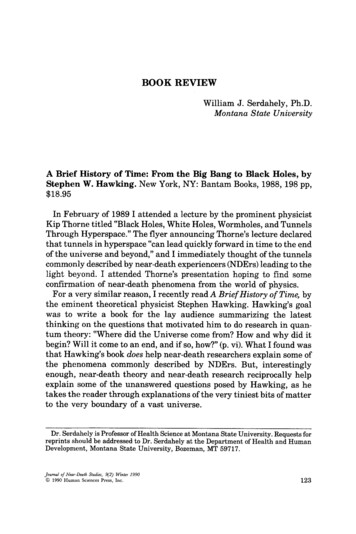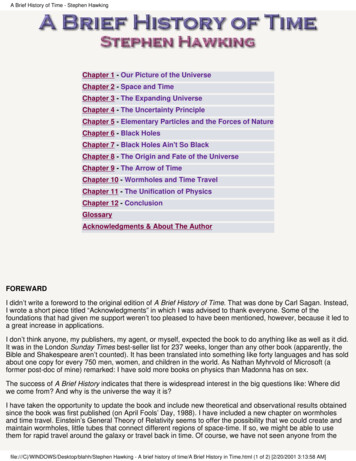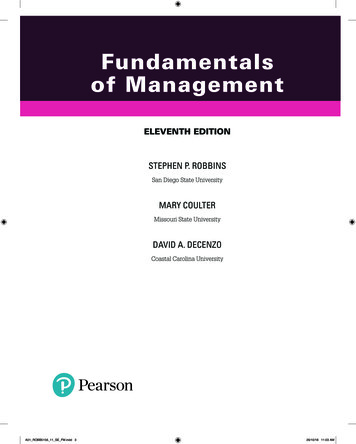
Transcription
BOOK REVIEWWilliam J. Serdahely, Ph.D.Montana State UniversityA Brief History of Time: From the Big Bang to Black Holes, byStephen W. Hawking. New York, NY: Bantam Books, 1988, 198 pp, 18.95In February of 1989 1 attended a lecture by the prominent physicistKip Thorne titled "Black Holes, White Holes, Wormholes, and TunnelsThrough Hyperspace." The flyer announcing Thorne's lecture declaredthat tunnels in hyperspace "can lead quickly forward in time to the endof the universe and beyond," and I immediately thought of the tunnelscommonly described by near-death experiencers (NDErs) leading to thelight beyond. I attended Thorne's presentation hoping to find someconfirmation of near-death phenomena from the world of physics.For a very similar reason, I recently read A Brief History of Time, bythe eminent theoretical physicist Stephen Hawking. Hawking's goalwas to write a book for the lay audience summarizing the latestthinking on the questions that motivated him to do research in quantum theory: "Where did the Universe come from? How and why did itbegin? Will it come to an end, and if so, how?" (p. vi). What I found wasthat Hawking's book does help near-death researchers explain some ofthe phenomena commonly described by NDErs. But, interestinglyenough, near-death theory and near-death research reciprocally helpexplain some of the unanswered questions posed by Hawking, as hetakes the reader through explanations of the very tiniest bits of matterto the very boundary of a vast universe.Dr. Serdahely is Professor of Health Science at Montana State University. Requests forreprints should be addressed to Dr. Serdahely at the Department of Health and HumanDevelopment, Montana State University, Bozeman, MT 59717.Journal of Near-Death Studies, 9(2) Winter 19909 1990 Human Sciences Press, Inc.123
124JOURNAL OF NEAR-DEATHSTUDIESThroughout the book, Hawking strives to find a complete, consistent, unified theory" of '%verything in the universe" (p. 155), the unification of physics theory. While remaining cautiously optimistic andrealizing that physicists in the past were wrong when prematurelyconcluding they had discovered just such a unifying theory, Hawkingsuggests that the string theory" may be 'the long sought-after unifiedtheory of physics" (p. 165). String theory postulates that a particle mayoccupy any one of a number of positions along a line, as if on a string.The string may be open-ended or closed in a loop-form, and the stringmay travel along a two-dimensional surface. Hawking concludes hisdiscussion of the unifying theory of physics by writing: "A complete,consistent, unified theory is only the first step: our goal is a completeunderstanding of the events around us, and of our own existence" (p. 169).As I read this last line, the near-death researcher in me could nothelp but think that the synthesis of the unification theory of physicswith the theory of the near-death experience (NDE) gives us one way tomeet Hawking's goal of understanding the events around us and ourown existence. The synthesis of these two seemingly disparate areas ofstudy may give us a unification of a physics/metaphysics theory toprovide us with a more complete understanding of life, the universe,and the cosmos, from the smallest bits of energy of quantum mechanicsto the infinite loving energy of the Light. The answer may lie not in acompetition between physics and metaphysics for the right" unifyingtheory, but in the integration of the two. With this in mind, I did findseveral ways in which physics and near-death studies interconnectwith one another as I read A Brief History of Time.Hawking's book helps near-death research in at least four ways.First, Hawking provides a physicist's explanation of time, which insome ways is not unlike the concept of time described by NDErs.Second, Hawking gives the reader a brief lesson in the history of thescience of physics, a lesson that has great relevance for near-deathresearch. Third, he clearly lays out the scientific methodology ofphysics, a process with implications for near-death research. And last,Hawking takes us on a journey into fantastic and unbelievable physical realms, from which I was left wondering which was more incredible, the realm of quantum mechanics or the realm of the NDE.TimeThe string theories mentioned above ' seem to be consistent only ifspace-time has either ten or twenty-six dimensions, instead of the
BOOK REVIEW125usual four" (p. 162). While Hawking does not explain why the numbers10 and 26 are predicted by string theories and while we are stilldealing with theoretical physics here, there is, nevertheless, the suggestion t h a t other dimensions m a y exist besides the three spatialdimensions and the one temporal dimension of "ordinary reality."Perhaps one or more of these additional dimensions are where ourNDErs travel during their out-of-body experiences.Since the advent of the theory of relativity, Hawking says, we areforced to abandon our notion of absolute time. "Thus time became amore personal concept, relative to the observer who measured it" (p.143). "Each observer has his own measure of time" (p. 87). Near-deathresearchers are quite familiar with the myriad descriptions of timegiven by NDErs: from time being distorted; to time being impossible todetermine CThe NDE could have t a k e n a second or an e t e r n i t y - I justdon't know which"); to "It seemed as if I was travelling at the speed oflight." The near-death literature clearly shows the personal and relative n a t u r e of the descriptions of time given by NDErs.Last, Hawking introduces us to a concept called "imaginary time,"which is a well-defined mathematical concept, according to the author.If one measures time using imaginary numbers, r a t h e r t h a n real ones,the distinction between time and space disappears completely. Thereare no differences between the forward and backward directions ofimaginary time; one can go in either direction. Hawking writes,This might suggest that the so-called imaginary time is really realtime, and that what we call time is just a figment of our imaginations.In real time, the universe has a beginning and an end at singularitiesthat form a boundary to space-time and at which the laws of sciencebreak down. But in imaginary time, there are no singularities orboundaries. So maybe what we call imaginary time is really morebasic, and what we call real is just an idea that we invent to help usdescribe what we think the universe is like. (p. 139)For students of the near-death experience, what Hawking is sayinghere seems quite similar to what NDErs collectively say about theirexperience: t h a t their NDE was more real t h a n ordinary reality; t h a ttime doesn't exist in an NDE as it does in "real" life; t h a t one could seethe present, the past, and the future simultaneously during the NDE,or t h a t one could go backward and forward in time during the NDE;and t h a t the paradox is t h a t what we t h i n k is real is n o t - t h a t nearlydying tells us t h a t our real home is in the light and our imaginaryhome is in our physical bodies.
126JOURNAL OF NEAR-DEATHSTUDIESHistory of the Science of PhysicsHawking, in a nonsystematic way, alludes to the history of thescience of physics throughout his book. Several of the points he makesabout research in physics are relevant for research into the near-deathexperience.First, we know from the history of physics that a concept can be putforth, and even accepted, even though that concept has not been detected or proven. For example, gravitons, ' what classical physicistswould call gravitational waves," have never yet been observed (p. 70)and yet are an accepted concept of physics. Neutron stars could not beobserved when first predicted and were not detected until much later(p. 84). And black holes were theorized before observational evidencesupported the theory. Opponents of the black hole theory used to arguethat ' how could one believe in objects for which the only evidence wascalculations based on the dubious theory of general relativity?" (p. 92).Near-death researchers may take heart from our colleagues in physicswho have been, and still are, confronted with the situation of developing a theory before there is enough evidence to substantiate thattheory, the same position in which we near-death researchers frequently find ourselves.A second point to come from Hawking's understanding of the scienceof physics is that what we know today may be very different from whatwe will know in the future. Thorne said in his lecture that it took 50years before there was enough evidence for the scientific community toaccept the phenomenon of black holes. Hawking points out that whatwere considered the elementary particles of 20 years ago are not theelementary particles of today. The history of physics has numerousexamples of changes in the establishment's thinking and the evolutionof theories over time, such as a geocentric universe to a heliocentricone to the Earth on a spiral arm of the Milky Way galaxy; or Newtonian physics to the theory of relativity to quantum mechanics to thestring theory. Again, near-death researchers should take heart thatjust because we can't explain or prove today everything NDErs tell usabout NDEs doesn't mean that we won't have more evolved explanations or more powerful evidence in the future. It took physicists severalcenturies of research to get to where they are today; near-death research started in earnest in 1975.H a w k i n g also points out that criticism of new ideas from contemporaries happens within his field. Indeed, it happened to him as he waspresenting his findings on the emission of radiation from black holes.His idea aroused a lot of opposition initially because it upset the
BOOK REVIEW127existing viewpoint, as the prevailinj, thinking at that time was just theopposite. So, again, even though our colleagues from various scientificdisciplines and medical fields m a y call the near-death experience nonsense, just as a H a w k i n g colleague so labeled Hawking's calculationson black hole emissions, calculations that turned out to be correct, wem a y take comfort in knowing that near-death research may then bechallenging the prevailing paradigm of science. Near-death researchm a y be upsetting the "existing viewpoint" from which paradigm shiftsare made.PredictionsThroughout the book, H a w k i n g alludes to the methodology of astrophysics. His point is that current theories are, of course, based on themeasurements and the observations made so far. But in order for atheory not to be discarded, it must make predictions with respect tofuture observations and experiments.Near-death studies, while still in their infancy, are beginning tomake just such predictions. The work of Kenneth Ring, Bruce Greyson,Melvin Morse, and others on the aftereffects of NDEs is an example ofbeing able to make predictions based on the current theoretical model.As near-death studies evolve as a science, we will need to look moreand more at the predictability of our theories within the science. Forexample, if our theory is that a Stage 5 near-death experience redirectsa person's life in a more spiritual way, will we be able to predict whothen might have an NDE?What's More F a n t a s t i c ?As I was reading Hawking's book, he introduced me to a universe ofphysical phenomena that seem fantastic and incredible to me: blackholes; imaginary time; antiparticles, antitime, antipeople; quarks,gluons, mesons; supergravity; a umverse with a boundary; the totalenergy of the universe being zero; the fact that the light I see coming inmy window as I write this left the sun eight minutes ago; time measured in light years so that the dots of light I see in the night sky m a ybe from stars long ago extinguished or are from stars that are actuallyin another part of the night sky but look like they are where they aredue to the bending of light from gravitational forces. These are amazing concepts and phenomena to my mind.
128JOURNAL OF NEAR-DEATHSTUDIESAnd so I began to wonder what is more amazing, the concepts inHawking's book, or these: having an out-of-body experience and beingable to describe accurately medical resuscitative measures being performed on one's body; traveling through a dark tunnel; having a lifereview; experiencing no sense of time; getting a peek at the future;meeting a deceased relative who sends one back to one's body; feelinglove and acceptance from the being of light? I don't t h i n k what we aretalking about here is a binary proposition. Both Hawking's universeand the NDEr's universe are amazing. Perhaps we are simply talkingabout a universe unfamiliar to a respective group of researchers. As anear-death researcher, I am not highly familiar with the universe ofphysics. And, it may be t h a t m a n y of the physical scientists are just notfamiliar with the universe of NDErs. Perhaps it's the unfamiliarityt h a t makes it seem unbelievable.The more I read and thought about Hawking's book, the more convinced I became t h a t a reciprocity exists between near-death researchand astrophysics research. Not only does research in physics helpexplain some of the NDE findings, but near-death research helpsanswer some of the questions posed by Hawking in A Brief History ofTime.Four DimensionsAt the end of the book, Hawking writes, The question remains,however: How or why were the laws and the initial state of the universe chosen?" (p. 173). Why is it t h a t we live in three dimensions ofspace and one dimension of time?Near-death research does provide a possible answer for Hawkinghere: The above conditions allow h u m a n s to experience pain. Unlikeour NDErs who almost to a person say they were painfree while intheir altered state of consciousness or in another dimension of theuniverse, the three dimensions of space and the one dimension of timeprovide both physical and psychic pain from which there can be transformational experiences for t h a t person's psychological and/or spiritual growth.Our P l a c e in the U n i v e r s eAlso in the conclusion of his book, Hawking says:We find ourselves in a bewildering world. We want to make sense ofwhat we see around us and to a s k : . . , what is our place in [theuniverse] and where d i d . . , we come from? (p. 171)
BOOK REVIEW129Again near-death studies offer some help here.It is not uncommon to hear people who have had deathbed visions saythey are going home," back to ' the Light." In the altered state ofconsciousness when near death and looking up to greet the spirit orspirits who have come to assist in the transition, the dying personmight say something to the effect that these spirits have come to takehim or her "home." The implication then is we come from the Light andwe go back to the Light, which is one answer to Hawking's questionabove.EntropyH a w k i n g talks about a 'thermodynamic arrow of time," a directionto time in which disorder or entropy increases. The increase of disorder or entropy with time . . . distinguishes the past from the future,giving a direction to time" (p. 145).He asks why the thermodynamic arrow of time exists at all. He thenproceeds to try to answer that question, first by using the classicaltheory of general relativity and then by using the quantum theory ofgravity, concluding by saying that his revised calculations show thatentropy would still increase with a universe contracting on itself.But as I read this section on entropy, I thought about another explanation, not incompatible with the physical explanations, for the secondlaw of thermodynamics: without entropy, there would be no death.And, without death, there could be no return to the realm or thedimension(s) of the near-death experiencer. So here again we see howthe synthesis of physics concepts with NDE concepts can provide uswith a fuller understanding of the universe. "A complete, consistent,unified theory [of physics] is only the first step: our goal is a completeunderstanding of the events around us, and of our own existence" (p.169), writes Hawking. And so it is that with the synthesis of these twoseemingly disparate disciplines that we can begin to approximateHawking's goal for a complete understanding.GodCarl Sagan, who authored the introduction to Hawking's book,states:This is also a book about God. . . . The word God fills thesepages . . . . Hawking is attempting to understand the mind of God. And
130JOURNAL OF NEAR-DEATHSTUDIESthis makes all the more unexpected the conclusion. :a universewith no edge in space, no beginning or end in time, and nothing for aCreator to do. (p. x)Hawking makes a similar statement:But if the universe is really completely self-contained, having noboundary or edge, it would have neither beginning nor end . . . . Whatplace, then, for a creator? (p. 141)While Sagan and Hawking seem to have limited themselves by making the assumption that God has no role in the universe once theuniverse was started and then is functioning according to precisephysical laws, once again near-death studies provide us with an expanded vision of God.First, we do get an understanding of the mind of God from NDErswho have been enveloped by the Light. We are told the Light isunconditionally loving and forgiving, and intelligence itself. Second,we know from near-death studies that God is not as passive as Saganappears to suggest and as Hawking seems to wonder. Perhaps God doesnot intervene in the physical laws governing the universe once the BigBang, or whatever has started the process, has taken place. But weknow that God may intervene in the lives of NDErs, hardly a passiverole. For example, the near-death literature has many cases where theN D E r is either given a choice by the Light to return to the body ordirectly told by the Light that this is not the right time for this person,and that he or she must return to the body. Also, the Light has a mostimportant role in the life review where the NDEr feels all the pain heor she has inflicted on others. Without the loving and forgiving Presence present during this kind of life review, such a life review would,indeed, seem to be a most unbearable task.ConclusionH a w k i n g concludes his book with the following thoughts. The scientists have been busy trying to describe what the universe is and havenot asked why. Philosophers have asked why but don't have the technical background to keep up with the what question. Therefore, "if we dodiscover a complete theory, it s h o u l d . . , be understandable in broadprinciple by everyone, not just a few scientists. Then we shall all,philosophers, scientists, and just ordinary people, be able to take part
BOOK REVIEW131in the discussion of the question of why it is that we and the universeexist" (p. 175).Even though he doesn't say it, Hawking implies here that the complete theory m a y lie in the collaboration and cooperation of specialistsin quite diverse fields. He does mention "ordinary people" taking partin this discussion, too, and it is interesting to note that more t h a n oneNDEr, having had a deep near-death experience, has come back saying, "I don't know why God or Jesus talked to me; there's nothingspecial about me. I'm just an ordinary person." So before we become toopretentious with our specializations, we need to be willing to listen toeveryone, regardless of training, who is willing to participate in thisdiscussion.Thus, one step toward achieving a complete theory of why we and theuniverse exist would be the synthesizing of near-death research findings, based, in part, on what we are told by "ordinary people" who t u r nout to be "extraordinary people," with the unification of physics theory.For those engaged in the research of astrophysics, reading Moody's andRing's works would be just such a start. And, for those of us engaged innear-death research, reading Hawking's book seems a most helpfulbeginning.
Stephen W. Hawking. New York, NY: Bantam Books, 1988, 198 pp, 18.95 In February of 1989 1 attended a lecture by the prominent physicist Kip Thorne titled "Black Holes, White Holes, Wormholes, and Tunnels Through Hy











